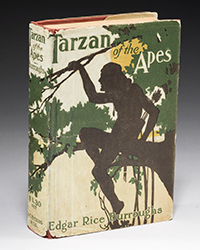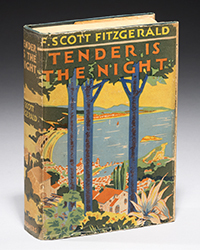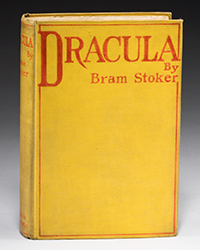What’s it worth? How old is it? Is it a first or a reprint? How often does it show up?
Here’s a short guide on how to start to answer those questions.
Unless I have a written provenance from a reliable source, I begin with an internet search and usually use https://www.addall.com/used/
The best feature of this free database is that it aggregates results from many sources. This includes all the standard ones such as ABE, Alibris, Amazon, and also many of the more esoteric ones too. If the same book is listed multiple times on different sites, Addall shows all the various listings individually. Increasingly it shows photos of the actual copy being offered. Reviewing the search results usually yields a pretty good idea of how many copies are actually out there, as well as the range of high to low asking prices.
The settings on AddAll are easy, and perhaps even a little primitive. I set it by “price” to show the highest priced items first, i.e.”descending” order. I get better preliminary results if I use a very basic search: author, title, publisher. I often don’t include date or edition on the first pass because I want to see the whole spectrum including limited, signed and other desirable features in the more expensive copies first and reprints, and later printings at the low end.
Addall usually gives a quick ballpark idea of how many copies are currently available and how many of the listings are duplicates. It also tells where they are located. Sometimes I disregard overseas and Canadian listings because international shipping costs so much that the final price becomes prohibitive. On Addall it is common to see the same exact book described by the same exact dealer on five different bases with some variation in price depending on the terms of that platform.
I prefer to see results in descending order, which means the more expensive offerings come up first. I don’t usually pay much attention to the asking prices, especially from little known vendors. What I watch for is WHO is doing the asking and I read the details in their descriptions. The better dealers, nationally and internationally, have better catalogers, access to more bibliographies and their descriptions often offer much more detailed specific information about points of issue.
So if Peter Harrington in London says to watch for the broken letter t on page 62, or William Reese’s listing describes the difference between a first and second state dust jacket as one has a border and the other does not, I’m apt to take these very small differences seriously and include them in my own description if applicable. You are allowed to mention that other dealers list these points as desirable features, you are not allowed to copy or plagiarize their listings.
So Addall is my first stop. How many copies? Who has them? What’s the price range? What’s the condition range? Any really wonderful ones with inscriptions, marginal notes, autographed by the author, and gifted to someone notable, association? All of those factors enhance the value. How does my copy look in comparison?
If the Addall search comes up blank or with not very good info, I’ll type the author and title into Google search and click “shopping” at the top of the pages. Sometimes, but not always this search will turn up copies that are listed by internet sellers who use auction sites like eBay. Remember that the important numbers are how many have sold recently and at what price. The “sold/completed” function on ebay is a fairly good indicator of how popular or commercial a particular title is; but it’s only a so-so indicator of actual value because many eBay booksellers have a thin knowledge of what they are selling or how to accurately describe it.
Likewise, I use Google Lens to match the photo of the book I have in my hand with the other images of copies that may be floating around the internet. Google Lens is that little camera icon in your Google search bar. If you don’t see it, type "google lens" into your search and the camera icon should appear. Then drop the photo of the item you wish to compare into the space, and Voila!, if there are any exact or similar matches they will appear. Will they have a price or an accurate description? Maybe not, but at least it’s a place to start.
While eBay is a very broad indicator of current interest, which sometimes translates to value, the accuracy of eBay descriptions vary widely, and are frequently unreliable or worse yet deceptive. Same for that bugaboo “Certificate of Authenticity.” Very few of the top firms use these. Even seeing that phrase in a description makes me distrust the vendor.
Shameless Self promotion - Rare Book Hub has a visitor pass
If you suspect you have a genuinely rare or uncommon book, probably the best way to find out what it is and what it’s worth is to look it up on Rare Book Hub. The RBH results show the actual date and selling price at auction (as opposed to dealer asking price) and also indicates how frequently a particular title or specific edition has come to market, when, who sold it and there is often a detailed description and sometimes a photo as well. Using RBH as a pricing guide for better antiquarian material takes a lot of the guesswork out of valuation.
As a writer for RBH I get an annual membership, but others might find RBH’s visitor membership attractive. It comes in two versions: A ten day pass is $65. The other option for 30 days of unlimited use for $95.
While this might seem steep if you’ve just got one or two titles, it can be worthwhile if you’ve got a stack of potentially valuable books or the contents of your dead uncle’s library and want detailed accurate information drawn from RBH’s over thirteen million auction records.
For those who handle high end material more often and want to make more frequent inquiries there are several other plans on an annual basis for single, multiple and institutional users.
If you live in San Francisco and have a library card you can access RBH records through the public library system.
Picky, picky, picky
Those are a few big picture ways to find things out. But sometimes some picky little details can be useful too. For example: zip codes, barcodes and SBN or ISBN numbers are all mid to late 20th century additions to information displayed on the title, copyright page or dust jacket. Knowing when they were adopted can help you date a book that doesn’t show a date, or that shows a date that you suspect is false.
In postal history the two digit postal code began in 1943 and was only used for 178 larger cities.
Next came the Zone Improvement Plan aka ZIP Code. It was first introduced in 1963 and became mandatory in 1967.
The two letter standardized state abbreviation list also began in 1963. There has been only one change since then. The abbreviation for Nebraska changed in 1969 from NB to NE to avoid confusion with the Canadian province of New Brunswick.
In 1983 the ZIP+4 was introduced.
So it is possible to roughly estimate the age of a mid to late 20th century book by counting the digits on the zip and noticing the presence or absence of a bar code.
Barcodes came in in the 1970s. According to the History of Barcodes it wasn’t until 1974 that the first barcode scanner was employed and the first product barcoded. Without going into a lot of other arcane detail, if you see a barcode anywhere on your item, no matter how old and rare it looks, it was published after 1974.
As for SBN and ISBN numbers the “Books Tell You Why" blog has an interesting history of this multi-digit book identification number system which includes a section titled “Why Should Book Collectors Know About ISBNs?” explaining how this number can help track down precise editions of specific titles.
This and That
When looking at paperbacks, first introduced in 1935, smaller is usually older. Pay attention to the cover price. Same size, same number, but different cover price, the less expensive cover price is the older copy.
As the 20th century moved along the paperbacks got bigger. So the corollary is the bigger the paperback the more recent it is likely to be.
Because some important books, especially in science fiction, came out first as paperbacks (or were sometimes published in part or whole in magazines) there are some paperbacks of considerable value. The same holds true for the right issue of the right magazine or newspaper.
And finally a working knowledge of paper and printing will go a long way in helping to identify that mysterious item you haven’t quite figured out. It looks old, but is it? You can forge the book, but it’s a lot harder to fake the paper.
I usually trust my fingers over my eyes. It’s easy to fool the eye, hard to fool the hand. When all else fails feel the paper. Is it a flexible rag based material (likely to be older) or brittle and yellowing wood pulp (much more recent)? Is it letterpress or offset? Your fingers can feel the difference.
If you love James Bond and run into a wonderful copy of Casino Royale which seems to match all the points of a first edition, but has a strange paper you don’t quite recognize plus an odd Chinese character or two, hold on tightly to your credit card, it’s a Taiwan pirate edition.
For a more complete illustrated explanation see the IOBA online article Comparing an American First Edition to the Taiwan "Pirate" Edition Next time you won’t be fooled.
And finally, if it's graphic arts and you are a complete beginner buy The History of Printmaking, published by Scholastic in 1996. It's written for children, but grown ups can learn a lot from this compact, inexpensive, easy reading, cleverly designed, colorfully illustrated title. A "google shopping" search brings up quite a few copies priced from $1.99 to $7.00.
Reach RBH writer Susan Halas at wailukusue@gmail.com
NB: After RBH posted this story we received a nice letter from Bill McBride, which we would like to share with our readers.
He wrote: "Just read your article on Rare Book Monthly and have some comments:
Some of your guidance is excellent, but I do not see what reference guides one should consult to help in the determinations you outline. Perhaps the assumption is that book collectors already possess those references. Our experience is that many do, and many more do not. The same goes for dealers who list on Abebooks & elsewhere, based on many listings I have observed.
ZIP Code began July 1, 1963, the middle of the year, a subtle point, but does come to bear on books published in 1963. Also, some publishers did not include ZIP code in their addresses well into 1964, some even later.
McBride goes on to point to two of his own publications: "Since 1979, I have been providing the resources that would assist anyone in answering some of the questions you pose. The first question about any book one should get an answer to is "Is it a first?"
1. A Pocket Guide to the Identification of First Editions, 7th edition [identification methods of 5,835 publishers world-wide in English. ($19.99 plus shipping)
2. Points of Issue: A Compendium of Points of Issue of Books by 19th-20th Century Authors, 3rd edition [which, per your mention of bar codes, covers books by E L Doctorow, Joan Didion, John Grisham, Stephen King, John Updike & a few more. Correct bar codes may appear on any given jacket, but on the trade edition, the price is echoed at the head of the barcode panel, on the book club edition, the number is something like 017600, not an echo of the price. ($17.95 + shipping)
This guide also addresses points of issue on dust jackets, primarily because jackets & books can be married to create a false impression of the two together. Further, in the last 15 years, many book club editions use exactly the same text block type, including the copyright page, so that if the dust jacket upper right corner where the trade edition would show a price, is snipped, the book would appear to be a correct first. If one had both the trade 1st & the book club version side by side, evidence would be clear. Lacking the two, a collector or dealer could easily be fooled. Typically, the trade edition will be bound more substantially than the book club edition].
In summary, I applaud your effort. And I would like to add my recommendations to any revised edition you might create.
With wishes for better books at better prices,
Bill McBride
The two guides mentioned above are available from:
The Jumping Frog
56 Arbor Street Suite 107
Hartford CT 06106 860-523-1622
www.thejumpingfrog.com eBay seller name: thejumpingfrog




















![<b>Sotheby’s, Dec. 11:</b> Darwin and Wallace. On the Tendency of Species to form Varieties..., [in:] <i>Journal of the Proceedings of the Linnean Society,</i> Vol. III, No. 9., 1858, Darwin announces the theory of natural selection. £100,000 to £150,000. <b>Sotheby’s, Dec. 11:</b> Darwin and Wallace. On the Tendency of Species to form Varieties..., [in:] <i>Journal of the Proceedings of the Linnean Society,</i> Vol. III, No. 9., 1858, Darwin announces the theory of natural selection. £100,000 to £150,000.](https://ae-files.s3.amazonaws.com/AdvertisementPhotos/00d5fd41-2542-4a80-b119-4886d4b9925f.png)






![<b>Heritage, Dec. 15:</b> John Donne. <i>Poems, By J. D. With Elegies on the Author's Death.</i> London: M[iles]. F[lesher]. for John Marriot, 1633. <b>Heritage, Dec. 15:</b> John Donne. <i>Poems, By J. D. With Elegies on the Author's Death.</i> London: M[iles]. F[lesher]. for John Marriot, 1633.](https://ae-files.s3.amazonaws.com/AdvertisementPhotos/8caddaea-4c1f-47a7-9455-62f53af36e3f.jpg)



